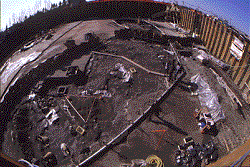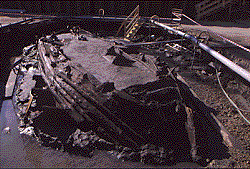

| |
| A Cache of Vintage Ships | Volume 52 Number 4, July/August 1999 |
|
by Andrew L. Slayman Photographs by Giovanni Lattanzi |
|
(Newsflash: Two more ships have been found. Go to preliminary report.)
 |  |
| Nine Roman ships have been uncovered during construction at Pisa's San Rossore train station. Ship D (right), a small utilitarian vessel, is the best preserved. |
Summoned last April to survey a construction site in Pisa, Italian archaeologist Stefano Bruni never imagined what he would find: nine well-preserved Roman ships--the largest group of ancient vessels ever discovered in a single place--and part of Pisa's classical port. Eight months of patient testing had yielded little, and construction of an office building at the San Rossore train station was proceeding. Then, in December, builders sinking a corrugated steel retaining wall to support the sides of the foundation pit realized they had bisected an ancient ship, nearly intact, its wooden frame and planks still held together by copper nails. During the next five months, eight others were found, dating between the second century B.C. and the fifth century A.D., from Pisa's florescence as a Republican naval naval base to the end of the Roman Empire. Bruni's original cores had stopped in what seemed like sterile soil three inches shy of the discovery of a lifetime.
 |
Clad in a professorial tweed jacket, pipe in hand, Bruni, of the Archaeological Superintendency of Tuscany, surveys his domain with the confidence of a man whose name is made. The vast foundation pit, nearly 300 feet long and 150 feet wide, stretches out before us, a temporary concrete floor interrupted at intervals by green corrugated plastic roofs supported on scaffolding. Beneath each shelter, archaeologists from the Florence-based contract firm Co.Idra, working under Bruni's supervision, are excavating the ships and documenting the finds. Journalists from all over Europe have flocked to see the ships, but despite the media attention Bruni remains firmly focused on their archaeological significance. "This find is extremely important not just on a local level," he tells me. "We have now discovered part of the harbor of one of the greatest ancient Mediterranean ports, with ships practically intact." Study of the vessels will allow marine archaeologists to add to their knowledge of Roman shipbuilding techniques, while analysis of their cargoes--including wine, olives, and fruit--will contribute valuable new data to the study of classical trade.
 |
| Cargoes like wine, olives, and fruit were transported in amphoras, thousands of whose sherds were found at the site. |
With at least two sheltered harbors, Pisa was an important Roman naval asset, and ancient sources mention fleets setting out from it for Gaul and Spain during the Second Punic War (218-201 B.C.). Thanks to Bruni's excavations, the area of San Rossore is now recognized as site of the Porto delle Conche (Port of the Basins), a small tidal lake near the mouth of the Auser River mentioned by the sixteenth-century historian Raffaello Roncioni. In antiquity the Porto delle Conche was evidently one of Pisa's harbors, and, as in any harbor, some vessels sank or were abandoned at anchor. During the past 2,000 years, large amounts of silt washing downriver were deposited on the basin floor, covering and protecting ships as they sank and eventually filling the basin altogether. 
Introduction | Ship A | Ship B | Ship C | Ship D | Other Ships | A New Museum?
© 1999 by the Archaeological Institute of America archive.archaeology.org/9907/etc/pisa.html |
Advertisement

Advertisement






